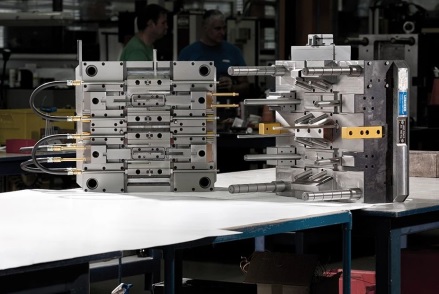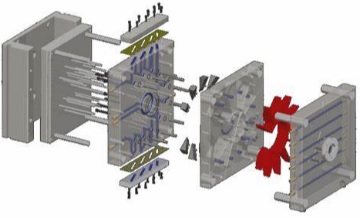A Set of Mold Design Ideas and Processes
A set of reliable plastic mold design is mainly reflected in the quality of the molded plastic products (appearance quality and dimensional stability), convenient, rapid, and concise processing and manufacturing, which saves money and manpower, and leaves room for correction and improvement. It is safe, stable, easy to maintain, has a short molding cycle and a long service life during injection molding, and has reasonable mold manufacturing technology.

01 The main process of factory mold design
Customers provide product drawings→analyze products→confirm plastic varieties→confirm mold material→transfer engineering drawings→multiply and shrink to make a mirror image→improve assembly drawing→order mold base→order mold core material→draft→3D parting→determine runner /Gating method→Refer to the ranking drawing for structural design→dismantle inserts→correct 3D→engineering drawing (mold core/insert/mold blank/parts)→make BOM table→proof and review.
02 Several aspects that should be paid attention to in design
1) When we start the mold design, we should pay more attention to considering several options, weigh the advantages and disadvantages of each option, and choose one of them, and take the T mold seriously. Because of the time understanding, it was believed that a reasonable design at that time would definitely have possible improvements through production and use practices.
2) After handing over the design plan, communicate more with the factory to understand the processing process and the situation in manufacturing use. Each set of molds should have a fixed analysis experience, sum up the process of gains and losses, in order to continuously improve the level of mold design.
3) When designing, refer to similar drawings designed in the past to learn from its experience and lessons.
4) The mold design department should be a whole, and each design member cannot work independently, especially in terms of mold design conclusions. It must have a unique style.
03 Mould design basis
The main basis is the product drawings and samples provided to us by customers. Designers must carefully analyze and digest the products and samples. At the same time, they must check all items one by one during the design process.
1. Dimensional accuracy related to the correctness of dimensions
1) Plastic products with high appearance requirements and low dimensional accuracy requirements, such as toys, etc., except for the specific dimensions, as long as the other dimensions are in good agreement.
2) Products with strict external dimensions
· Whether the draft angle is reasonable.
· Product wall thickness and uniformity.
· Type of plastic. (Selection of mold steel and determination of shrinkage rate)
· Surface requirements.
· Product color.
In general, color has no direct influence on mold design. When the product wall is thick and the appearance is larger, uneven color is likely to occur; and the darker the color, the more obvious the product defects are exposed.
2. Is there any post-processing after the product is formed?
If there are products with surface electroplating and one mold has multiple cavities, you must consider setting up auxiliary runners to connect the products together, and then separate them after the electroplating process is completed.
3. Batch of products
The batch of products is an important basis for mold design, and the customer must provide a range to determine the number of mold cavities, size, mold material selection and life.
4. Injection molding machine specifications
5. Other requirements of customers
The designer must carefully consider and check to meet the compatibility requirements.

04 General process of mold design
1) Analyze and digest products and templates.
2) It should be understood whether the customer has requested the specifications of the injection machine to determine the size range of the mold.
3) Determine and rank the number of cavities.
4) The parting surface is determined.
5) If there is a row position, an oblique square structure should be understood first.
6) Design of gating system.
7) Confirmation of mosaic structure.
8) Design of ejection and reset system.
9) Cooling and heating system design.
10) Guiding and positioning device.
11) Determine the mold base and select standard parts.
12) Selection of mold steel.
13) Complete the structure drawing, mold blank drawing, and cutting.
14) Finally, print out the drawing, check it, and submit it to the mold design team leader and supervisor.
05 Trial and repair
Although the mold design is carried out under the expected process conditions when the molding materials and molding equipment are selected, people’s understanding is often imperfect. Therefore, after the mold processing is completed, trial mold tests must be performed to see the molded parts How is the quality. After discovering that it is always the case, repair the model to eliminate errors.
There are many types of undesirable phenomena in plastic parts, and the reasons are very complicated. There are reasons for molds and process conditions. The two are often intertwined. Before repairing the mold, according to the actual situation of the undesirable phenomenon of the plastic part, a detailed analysis and research should be carried out, and the remedy method should be proposed after finding the cause of the defect of the plastic part. Because the molding conditions are easy to change, the general approach is to change the molding conditions first, and only consider repairing the mold when the changing molding conditions cannot solve the problem.
Repair molds should be more cautious, do not act rashly if you are not sure. The reason is that once the mold conditions are changed, major modifications and restorations cannot be made.
06 Organize data and archive
After the mold is tested, if it is not used temporarily, it should completely wipe off the mold release residue, dust, oil, etc., apply butter or other anti-rust oil or anti-rust agent, and send it to the storage place for storage.
From the beginning of the design of the mold until the mold is successfully processed and passed the inspection, the technical data generated during this period, such as the task book, the part drawing, the technical manual, the mold assembly drawing, the mold part drawing, the base drawing, the mold design manual, and the inspection record Forms, trial and repair records, etc. shall be systematically sorted, bound, numbered and archived according to regulations. This seems very troublesome, but it is very useful for repairing the mold in the future and designing a new mold.


